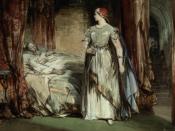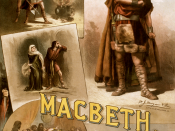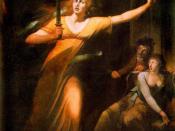Blood is known to all of us to represent life, death and often injury. Blood is an essential part of life, and without blood, we could not live. When Shakespeare uses the blood imagery to represent treason, murder and death, it is easily understood and fits in perfectly with the ideas we have of blood.
Blood is mentioned often in the play and most times in reference to murder or treason. The first reference to blood is in Act 2, Scene 1, when Macbeth sees the dagger floating in the air leading him to Duncan"s room and he sees "on the blade and dudgeon gouts of blood", indicating that the knife has been visciously and violently stabbed into someone. The next reference, in Scene 2, is when Lady Macbeth smears the blood from the dagger on the faces and hands of the sleeping servants "I'll guild the faces of the grooms withal, for it must seem their guilt".
This is another evil reference to blood, setting up the innocent servants of the king. Again, blood is referred to when Malcolm and Donaldbain are discussing what to do and Malcolm says: "there's daggers in men's smiles: the nearer in blood, the nearer bloody." Meaning that their closest relatives are likely to kill them. Again, blood imagery is being used.
In Act 5, Scene 1, the sleepwalking scene, while Lady Macbeth is sleepwalking, there are constant references to the evil deeds that Macbeth and herself have committed, most of which include references to blood imagery. She goes through the motions of washing her hands saying "Out damned spot! Out, I say" in reference to the blood that stained her hands after smearing it all over the servants. She also refers to Duncan"s murder saying: "Yet who would have thought the old man...


